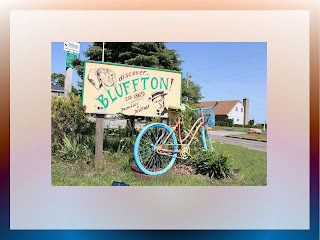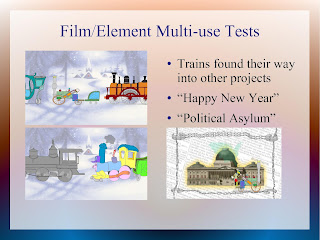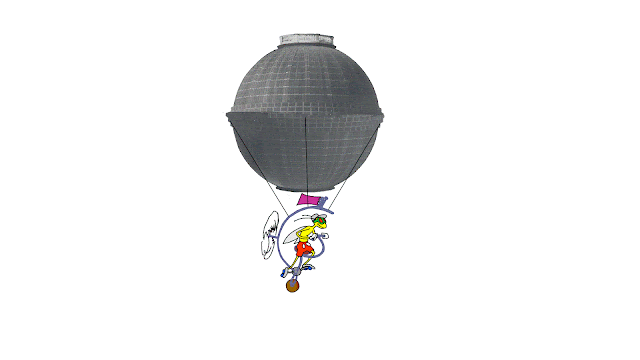 |
| (c) 2023 Jim Middleton, The Animating Apothecary |

Here lies the residue of "The Animating Apothecary," a source of obscure ephemera and thought, while nibbling at the crustier extremes of an overbaked society. Instagram? see - https://www.instagram.com/animating_apothecary/ also check out asifa.org and asifa.net - content (c) 2006-2025 Jim Middleton
Tuesday, August 29, 2023
Monday, August 28, 2023
Sunday, August 27, 2023
Post 599 - Now I'm Scared...
It took about 2 minutes to create this on heygen. We're doomed.
In a quieter moment:
And to think it took almost a week to assemble this classroom exercise in 2006:
Saturday, August 26, 2023
Wednesday, August 23, 2023
Post 596 - Another Extension checking for timing and color balance
Monday, August 21, 2023
Post 595 - Pencil Test - Extension of A Different Sequence - Version 1 - Next step on Post 596
Saturday, August 19, 2023
Monday, August 14, 2023
Post 593 - Writing a Village History or Sesquicentennial Book? Some Suggestions
Putting the Story in HiStory - Building the Tale of Your Small Town
 | |
| This is a photo of Edmore. Michigan, ca 1895. But it could be any small town of that era. |
While going through various celebratory books about small towns, I am struck how often the authors presume that their current situation will be The Forever Status of their hamlet, and that Everyone Will Remember Who this is, or What That was, or the Businesses that are here today are likely gone tomorrow, but everyone will remember these details 50 years from now.
To this I say, "Get over yourselves, people!" Historical documentation is getting aggressively shredded every day, and even a digital record is going to be wiped out with a magnet or an "improved" software that cannot replicate functions from DOS 6. High school grads in 50 years won't have a yearbook to review, yet alone laugh at.
Because of that, I offer this Outline Template for those aspiring to create a history of their little corner of heaven and preserve it for the years to come.
Spoiler Alert - it takes TIME and EFFORT
A. Basic Questions (these will be the permanent start to the book - later editions can build upon this, but this is the part of the book that should remain pretty constant):
- Why is your town here?
- Who laid things out? Where were they from? Did they stay? Did they move on? Were they "carpetbaggers" (came in, set things up, made money, left)
- How did it get its name?
- Where was the railroad? Where was the land route? Water route?
- Can you obtain a plat map of before/after the town was created?
- Do you have the earliest "map" of the town?
What was the first
- saloon
- "opera house"
- general store, drug store
- church
- cemetery
- school
- industry
- First families - who are the buildings named for in the town, who was the first "rich guy," the first doctor, druggist, barkeeper, general store manager, postmaster
- Boom years - why and how did the town grow?
- Bust years - don't be coy - sometimes a town shrinks and vanishes - share the lesson for others
Braggadocio and Scandals/Disasters? (fires were pretty common pre-WWI) - did the mayor run off with the school ma'rm? Did the town have a fit about all these new-fangled railroads and push to have it go to another town so "they'd have peace and quiet" (and become a ghost town)
B. Current items (which can be changed as time "wears on")
- families
- businesses
- churches
- schools
C. Process
- Get the stories transcribed first, then work on the text of the history before worrying about the layout.
- Gather all the visual, and LABELED, documentation that is possible.
- If there was a newspaper for the town, or of the area, look at and copy any earliest documents, especially as they pertain to any of the categories above.
- Take as many photos as possible, in as high a resolution as possible - "600 dpi" should be the minimal criteria.
- Create an INDEX to the contents.
- Create a list of all contributors and as much contact info as they feel comfortable in sharing - it can be their history, too, after all.
Assemble carefully with the text guiding you.
Use CAPTIONED photographs - credit year, location, individuals in the photos. If nobody has an idea, don't put it in the main text, save it as an appendix, "The Mysteries of... (insert town name here) Don't pepper your narrative with unidentified photographs. NOBODY WILL KNOW WHAT THEY'RE ABOUT IN 10 YEARS.
Once the text and layout have been completed, save the *.doc file, and then convert to a *.pdf for general review and comment.
At first, don't print the completed book beyond test copies - use the copies as fundraisers to have the entire volume published. Get extra copies for your museum/society/friend's attic. Amazon has a publishing arm, and you can get five copies, duly marked as NOT FOR SALE, for a low price to check your progress.
D. Assistance
Enlist high school and junior college students in sociology, history, journalism, graphic design - they'll do a lot of amazing things for credit in the project. It'll also help the students gain an appreciation for the area's history. AND GIVE THEM CREDIT IN THE ACKNOWLEDGEMENT SECTION!
Have an English teacher proof it over – again, useful connections at high school and junior college levels. Those sites will be the long-term repositories of your final opus.
Check the area and the state historic society - or the state library - there may be history preservation monies available.
NEVER GET TERRITORIAL - HISTORY IS NOT PROPERTY - WHATEVER IS NOT SHARED IS LOST - cooperation with larger, recognized entities will give the project credibility for fund raising - anything extra can go toward museum projects!
Any local businesses wish to help? Give them a page-size thanks at the end for their patronage.
E. Continuing the Story
Make a plan for an update every 5-10 years (more likely, 10-25, but be optimistic). Nothing is etched in stone, and even stone can't keep its story forever. You can keep the first section unchanged - just update the "newer" portion(s), unless some shocking truths reveal themselves.
Now play nice with each other, and preserve some history.
Sunday, August 13, 2023
Saturday, August 12, 2023
Post 590 - Some Meaningless Doodling
Thursday, August 10, 2023
Post 589 - Some Copyright Observations
Disney and Extending Copyright - Some Recent Examples
A few years ago, there was a vinyl picture-disc release of the soundtrack to Steamboat Willie, a soundtrack originally slated for the public domain in 2028. However, not this particular performance of that soundtrack - there are some subtle "adjustments" to this recording, notably a clean up from the Powers Cinesound system of the late 1920s. Anyone trying to use this particular performance could be visited upon by the Disney legal team, a notoriously humorless bunch of litigators.
Sticking to the same film, Disney + has a "tribute" to Mickey among its recent streaming specimens, in his "new" iteration called Steamboat Silly. In it, the "new" Mickey releases the 1928 black-and-white Mickey while showing a home movie - which is riddled with re-drawn scenes from Steamboat Willie. So, again, when 2024 arrives, the same legal dream team can sit on the front stoop of anyone making use of the original Mickey, claiming that it is making use of this recent version of the film, which will be under copyright until 2119 (96 years for "published works").
 |
| National Museum of American History |
 |
| from Cartoon Research |
%20title%20card.jpg) Silly Symphonies, anyone? Well, the classic 1929 Skeleton Dance has already gone through several variations from its 16mm EmGee film license, to VHS, to DVD, before this new streaming version on Disney +. The original release had a silent opening credit, then it was "modernized" with a faux intro music (that jarred against the actual soundtrack when it kicked in), then with an adjusted frame size to make it "authentic," then back to the silent opening for the Disney + production. Each soundtrack version represented a new "performance," with a 100 year long copyright attached. In addition, the new streaming version of Skeleton Dance has been given a digital cleanup, balancing contrast and flicker, cleaning the soundtrack, and even adjusting a sequence where the original film had the performing skeleton move off register from the background. Again, each of these versions represents a "new performance," and performances (ie, soundtracks) qualify for the 100 year copyright. The cleaned up visual version, as "published material," qualifies for 96 years.
Silly Symphonies, anyone? Well, the classic 1929 Skeleton Dance has already gone through several variations from its 16mm EmGee film license, to VHS, to DVD, before this new streaming version on Disney +. The original release had a silent opening credit, then it was "modernized" with a faux intro music (that jarred against the actual soundtrack when it kicked in), then with an adjusted frame size to make it "authentic," then back to the silent opening for the Disney + production. Each soundtrack version represented a new "performance," with a 100 year long copyright attached. In addition, the new streaming version of Skeleton Dance has been given a digital cleanup, balancing contrast and flicker, cleaning the soundtrack, and even adjusting a sequence where the original film had the performing skeleton move off register from the background. Again, each of these versions represents a "new performance," and performances (ie, soundtracks) qualify for the 100 year copyright. The cleaned up visual version, as "published material," qualifies for 96 years.This follows the production practice of Disney, from its VHS versions onwards, to not identify the copyright year of the film on the packaging - then it was to obscure the age of the movie ("1938! Eeuh! Old movie! Eeuh!"), but it also turned out effective to obscure when that film would be in the public domain (even with all that care, The Mad Doctor and Minnie's Yoo-Hoo slipped through the cracks) (people lost their jobs over that one, I'm sure).
So, if anyone is chomping at the bit to use these films, it'll be necessary to be certain that the 1928 and 1929 versions, specifically, are the source. Or, creating a different version, with a documented trail of production of drawing, rendering and artwork, will likely get past the realm of DisneyLaw. I suggest using a headless chicken, dressed and ready for Sunday dinner, piloting a tugboat. Have something like that whistle, and theater-goers will pack the aisles!
The ultimate irony of all this is that, had any of these current copyright laws been in place in 1928 or 1929, the musical cues that Walt, Ub, and Carl employed for these groundbreaking films would not have been in the public domain.
What a whirl'd.












































